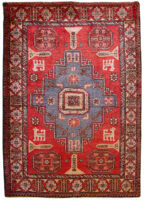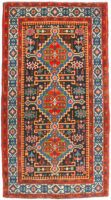Om Meschkin
Meschkin, Meshkin, Meshgin Meshgin is found north-east of Ardebil. Here you can generally find sensible and charming carpets at very good prices. The carpets knotted here are mostly carpet runners with stylised, somewhat stretched medallions. The dyes are often synthetic, camel hair coloured, blue, beige and a bit of red....Read more
Showing all 2 results
Showing all 2 results
Mere om Meschkin
Meschkin, Meshkin, Meshgin
Meshgin is found north-east of Ardebil. Here you can generally find sensible and charming carpets at very good prices. The carpets knotted here are mostly carpet runners with stylised, somewhat stretched medallions. The dyes are often synthetic, camel hair coloured, blue, beige and a bit of red. The warp and weft are made of cotton, and Ghiordes knots are used. The knot density is about 7,500-23,000 per ft2.
Meshkin lies in the Azerbadjan-province in Iran
Azerbaijan is found in the north-western corner of Iran, but it continues beyond the Iranian borders. It is an area that has been plagued by wars for centuries. The capital, Tabriz, was founded in the 7th and 8th centuries, but in the 1200s it was conquered by the Mongols under Genghis Khan. In the 1400s, Tabriz became the capital of Persia under the Turkmen. In 1514, the Ottomans entered the province and deported a large part of the population to Turkey. Under the Safavids in the 1500s, the entire province and town of Tabriz experienced a boom, and even back then the crafty town merchants began to organise carpet exports to Europe. I want to focus on the Iranian part of Azerbaijan because that is the area I am most familiar with. In the middle of the 1800s, Tabriz was a carpet production centre, exporting to the west via Istanbul. It has always been home to skilled merchants who could fulfil the West’s demand for carpets. Azerbaijan has a highland climate, with cold winters and warm, dry summers. The population density in Azerbaijan is relatively high compared to other Iranian provinces. The majority of the population is originally Turkish, Kurd or Armenian. A large portion is bilingual, speaking both the local Turkish dialect and Farsi, which is Iran’s official language. In this area, carpet knotting is performed by both nomads and residents. Of the resident population, knotting is carried out by both men and women. Among the nomads, it is primarily women’s work. You can still find good, sturdy and very wear-resistant carpets from the Azerbaijan area on the market, but production is decreasing, like in other areas of Iran. Many of the carpets being sold today were knotted in the 1980s and 1990s. These are carpets with great value for money. The patterns are often large octagons or stylised medallions with flowers and animals. In the actual town of Tabriz, many different patterns are knotted, including patterns that were originally knotted in completely different parts of Iran. Tabriz is a gathering point for carpets from the entire Iranian Azerbaijan region, i.e. carpets from Tabriz, Khoy, Heriz, Ahar, Mehrawan, Goravan, Karadja, Lambaran, Sarab, Ardebil, Meshgin and Miyaneh as well as carpets made by nomads. Kilde:
Source:
You are reading an extract from the book ‘Oriental Carpets, Knottet with Love’ by Martin Munkholm.
This extensive book about all that is carpets can be borrowed in Danish libraries or be bought following this link: https://belle-rugs.dk/se-taepper/bog-aegte-taepper-knyttet-med-kaerlighed/
The book is published by Muusmann Forlag.
For more info: http://muusmann-forlag.dk/
You can find our selection of Meshkin carpets below.


